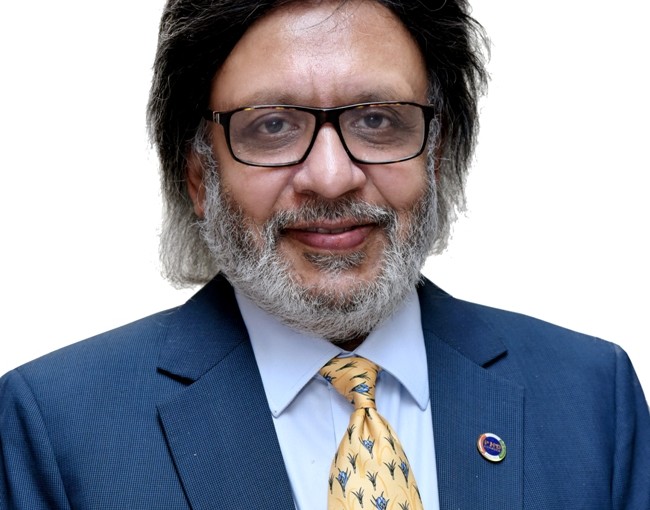

Mr. Anil Khaitan, President of the national apex chamber PHDCCI, in an interview with BUSINESS VIEWS Managing Editor G. Kalyan Kumar, discusses India’s business environment, investment climate, policy issues, budget, economic growth, employment generation and taxation issues. Mr. Khaitan is one of the leading industrialists in India. He is the CMD of Sunil Healthcare Ltd. Anil Khaitan holds an MBA from IMI Geneva.
- Do you think the current economic climate in India is pro-business?
Yes, the current economic climate is looking positive with signs of increased growth. The advantage is that economic uptick is happening in most parts of the world. The US is growing at 3 percent. The ASEAN is also at a healthy rate. It seems the world is getting out of the myopic mood it was in the last 4 years. There is a new optimism in most countries of the world. That will help India boosting its export growth.
In India, the government spent good money on improving infrastructure in the last three years with an adequate focus on rural infrastructure. That is reflecting in the improved demand as evident in the results of FMCG companies where top players have reported 18 percent growth. The growth in demand for the automobile industry is yet another proof. These two segments can be taken as broad indicators of the current economic growth.
Is there an area of concern in the outlook on the economy despite the uptick?
One major area of concern is job creation or developing entrepreneurship opportunities for 10 to 12 million youth a year who join the job market. It is to be seen how successful will be the government on that front. That will remain a major challenge until the SME sector kicks in a professional way rather than what it is doing now. After the agriculture sector, MSME is the biggest employer which number around 6 crores. India needs to fix the problems plaguing the SME sector for sharpening its professional skills so that it can increase the hiring capacity.
Is the MSME sector weakened by the low skilled workforce or is it drag in the absorption of technologies that are making it underperform?
It is both ways. When an MSME gentleman puts up a company, he must be having some expertise in the trade in purchase or sales. He is putting a life’s earnings into that and will not take any gamble. Having said that the big question is about creating mechanisms that can make them access the new technology and absorb them for implementing them in their factories or operations. If a product is made by an SME, to succeed in the market, they need the skill to market it. This calls for good marketing skills and MSMEs need to prepare for marketing their wares efficiently.
The government’s e-Market Place is a good initiative in addressing the marketing problems faced by MSMEs. The Railways have also started a portal for their purchases. After marketing comes, quality concerns on SME products. That can be addressed only by developing Centres of Excellence on skill development centers at industrial clusters. This will train the workforce well to develop super quality products.
What are the immediate needs of the MSME sector?
In addition to skill development initiatives now already in progress under the Skill India programme, the MSMEs also need a lot of support in improving their financial and digital literacy. They need more knowledge and training in managing finances and running the units efficiently.
Is it that MSMES lack a layer of professional leadership as most of them are run by individuals or family businesses?
Not at all, most entrepreneurs are born leaders. It is just that in today’s modern technological environment they come under pressure from issues such as demand for high-quality products and on-time delivery. For that, they need assistance from the professional world in putting the systems in place. That transition to greater excellence is already happening. Mention must be made of MSME clusters in some parts of Andhra and Telangana with a supply of comprehensive infrastructures such as power, roads, pollution drains, common facilities for solid waste storage and skill training centers.
Here the government can play a big role by monetizing the unused land lying with many public sector units as many of the factories are shut. The government can use that land to create the supportive infrastructure. The Chamber has already taken up the matter with Union minister Piyush Goyal. Some news reports also suggest that the government is making some plans on monetizing the land of PSEs. Going forward many positive initiatives will propel the manufacturing sector to better growth, unlike the agriculture sector where things are difficult.
Why is that the agriculture sector is trailing in job and wealth creation?
In the agri sector, too many people are contributing too less to the GDP. There is 60 percent of the population contributing 12 to 14 percent to the GDP. If India claims that it is an agrarian economy, how come in the last 70 years the country has not become Number 1 in agriculture? Why there is no cold chain infrastructure, or why 40 percent of the fruit production is perishing? Why are the farmers committing suicide? Why do the state governments have to waive farmers’ loans? Writing off farmer loans is a heavy drain of the state exchequer. This sends the message that it is the time we gave up politics over economics. Economics must prevail over politics.
Most of the recent geopolitical changes reflect such aspirations. The election of Donald Trump in the US, Narendra Modi in India is the outcome of attending to the economic aspirations of people who were ignored so far in economic development.
How far is the government fulfilling its duties as a facilitator for investment and business growth?
The government, it appears, is trying its best through its schemes and initiatives including the Mudra Bank and portal to ensure clearing of MSME bills. The government is also supporting industries through credit guarantee schemes. More reforms are expected in the MSME front. Ideally, there must not be any arbitrary investment ceiling as prevailed in the case of SSIs some 25 years ago. Investment limits need to be linked to the of the size of the enterprise governed by the number of employees and turnover.
In China, a company with a turnover of Rs 400 crore is an MSME. One can imagine the scale at which Chinese MSMEs are competing. The Indian MSMES have to go a long way in reaching that level. Here the rules say the maximum one can invest in plant and machinery is Rs 10 crores. The Chamber has been taking up the matter with all governments and is hoping some progress in the near term.
Are you hopeful that the upcoming Union Budget in February will address the aspirations of MSMEs?
We are hopeful that Finance minister Arun Jaitley will give due attention to MSMEs. In recent times, the FM has been talking more about agriculture and MSMEs and we take it as an indication that some action is in the offing. The government has also realized that unless MSMEs are looked after well the Reliances and Tatas cannot do all the work. By caring for MSMEs, the government can kill two birds with one stone. They will get the votes by catering to the entire bottom segment of the population. Secondly, you are diverting the money to the right cause of the country and making it economically viable.
Is the economic growth outlook on India satisfactory or is there a drag?
Going beyond the positive outlook of rating agencies like Moody’s or S&P, my expectation is that the Indian GDP growth will grow anything between 6.8 to 7 percent in the January—March quarter. The World Bank has also forecast 7.3 percent growth.
For making that kind of a growth a reality, India needs to concentrate on the top line. Now the good news is that the government has achieved the investment targets. They must set bigger disinvestment targets and vigorously tap non-tax revenue. Today, in the total revenue 75 to 80 percent is coming from direct tax revenue. The budget-making has been an exercise of playing around with direct taxes. It is no longer motivating. The tax base must widen and there are only 6 crore people paying taxes. There is an old joke that all finance ministers are like tailors, they alter the suite by cutting here and adding something there. Now the condition is that after tinkering the coat so long you don’t know where the coat is and where the pants. The time has come to make an entirely new suit that really fits the body structure of India.
How can the mismatch between Revenue and Expenditure be addressed?
The new budget should check the mismatch between soaring expenditure and falling revenue receipts. In rupee terms, India’s GDP is Rs 165 Lakh crore. So, if you are targeting 10 percent growth, there must be an addition of 16.5 lakh crore as income.
Do you support the Air India disinvestment?
Certainly, it is a right step, The 49 percent equity is the viable path. If Vistara—the JV of Tata’s and Singapore Airlines takes over Air India that will script a new chapter in India’s aviation sector. The combined contribution of Singapore Airlines hospitality, maintenance, crew and Tata’s goal of excellence will add a new grand value to the fliers and perk up the sector as a whole.
The introduction of GST has induced a climate of pessimism in some sectors of the business. How do you evaluate such concerns?
When there is a change there will be some resistance. But eventually, such businesses will start loving GST, say, after five years. GST is the outcome of merging 17 taxes and 23 cesses into a single tax and spells good savings. The GST will be a game changer for all. If the government can collect Rs 1 lakh crore a month, it will be Rs 12 lakh crore a year. Then the rates may also down probably to 5 percent. Currently, the indirect tax revenue per year is 8 to 8.5 lakh crores. Thanks to GST, there will be an additional Rs 3 to 4 lakh crores year flowing to government coffers. That will change the whole scenario. Now the fiscal deficit is 5 lakh 80 thousand crores. If GST supplies an average Rs 3 lakhs crore extra you can see how drastically the fiscal deficit can be cut.
What is the remedy to improve revenue receipts? The current scenario of expenditure overtaking the revenue receipts must change. The dismal situation is that India needs to borrow to finance the expenditure and again borrow to pay the interests part. To expand the revenue base, tax compliance needs to be encouraged by undertaking drastic tax reforms. The corporate tax must come down to 20 percent. When the tax structure is simplified tax evasion will disappear and that will curb the corruption in tax departments.How do you position PHDCCI distinct and unique vis a vis other top industry chambers such as CII or FICCI?
PHDCCI is not a pressure group and what it is doing is clean advocacy by projecting what is best for the industry and services including the cause of verticals like agriculture. Perhaps it is the first chamber among the 189 chambers in India that promoted the message of tax compliance among its members and spread awareness about paying taxes on time. Sometimes, chambers also have to be government’s voice. Wherever the government is right and people are not responding the chambers must step in and educate the fraternity.



